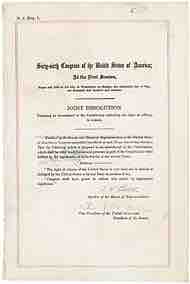Formal Methods of Amending the Constitution
The formal processes of amending the constitution are the processes articulated in Article V of the Constitution. These are the Congressional method and the Constitutional Convention methods.
In theory the two houses first adopt a resolution indicating that they deem an amendment necessary. This procedure, however, has never actually been used. The U.S. Senate and the U.S. House of Representatives instead directly proceed to the adoption of a joint resolution; thus, they mutually propose the amendment with the implication that both bodies "deem" the amendment to be "necessary. " All amendments presented so far have been proposed and implemented as codicils, appended to the main body of the Constitution .

Amendment Proposal
Resolution proposing the nineteenth amendment.
If at least two-thirds of the legislatures of the states make the request, Congress is then required to call a convention for the purpose of proposing amendments. This provision, many scholars argue, allows for a check on the power of the Congress to limit potential constitutional amendments.The state legislatures have, in times past, used their power to apply for a national convention in order to pressure Congress into proposing a desired amendment.
A classic example of this was demonstrated starting in the late 1890s. During that period a movement to amend the Constitution to provide for the direct election of U.S. Senators caused such proposals to regularly pass the House of Representatives only to die in the Senate. As time went by, more and more state legislatures adopted resolutions demanding that a convention be called. In response to this pressure the Senate finally relented and approved what later became the Seventeenth Amendment for fear that such a convention—if permitted to assemble—might stray to include issues above and beyond the direct election of U.S. Senators.
The President has no formal role in the constitutional amendment process. Article One provides that "every order, resolution, or vote, to which the concurrence of the Senate and House of Representatives may be necessary (except on a question of adjournment) shall be presented to the President of the United States; and before the same shall take effect, shall be approved by him, or being disapproved by him, shall be repassed by two thirds of the Senate and House of Representatives. "
As previously stated, the Constitution requires that at least two-thirds of the members present of both the House of Representatives and the Senate the agree to a joint resolution which proposes a constitutional amendment. However, in Hollingsworth v. Virginia (1798), the Supreme Court held that it is not necessary to place constitutional amendments before the President for signature and that, by the same logic, the President is powerless to veto a proposed constitutional amendment.
Ratification
After being officially proposed, a constitutional amendment must then be ratified either by the legislatures of at least three-fourths of the states, or by conventions in the same proportion of states. Of the 27 amendments to the Constitution that have been ratified, Congress has specified the method of ratification through state conventions for only one: the 21st Amendment, which became part of the Constitution in 1933.
Most states hold elections specifically for the purpose of choosing delegates to such conventions. New Mexico state law provides that the members of its legislature be the delegates at such a state ratification convention. It is unclear whether this New Mexico state law violates the United States Constitution.
Although a proposed amendment is effective after three-fourths of the states ratify it, states have, in many instances, ratified an amendment that has already become law, often for symbolic reasons. The states unanimously ratified the Bill of Rights; the Thirteenth Amendment, abolishing slavery; the Fourteenth Amendment, providing for equal protection and due process; the Fifteenth Amendment, prohibiting racial discrimination in voting; and the Nineteenth Amendment, granting women a federal constitutional right to vote. In several cases, the ratification process took over a century.